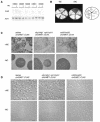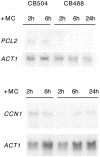Cyclin Cln3p links G1 progression to hyphal and pseudohyphal development in Candida albicans
- PMID: 15643065
- PMCID: PMC544164
- DOI: 10.1128/EC.4.1.95-102.2005
Cyclin Cln3p links G1 progression to hyphal and pseudohyphal development in Candida albicans
Abstract
G1 cyclins coordinate environmental conditions with growth and differentiation in many organisms. In the pathogen Candida albicans, differentiation of hyphae is induced by environmental cues but in a cell cycle-independent manner. Intriguingly, repressing the G1 cyclin Cln3p under yeast growth conditions caused yeast cells to arrest in G1, increase in size, and then develop into hyphae and pseudohyphae, which subsequently resumed the cell cycle. Differentiation was dependent on Efg1p, Cph1p, and Ras1p, but absence of Ras1p was also synthetically lethal with repression of CLN3. In contrast, repressing CLN3 in environment-induced hyphae did not inhibit growth or the cell cycle, suggesting that yeast and hyphal cell cycles may be regulated differently. Therefore, absence of a G1 cyclin can activate developmental pathways in C. albicans and uncouple differentiation from the normal environmental controls. The data suggest that the G1 phase of the cell cycle may therefore play a critical role in regulating hyphal and pseudohyphal development in C. albicans.
Figures





References
-
- Bai, C., N. Ramanan, Y. M. Wang, and Y. Wang. 2002. Spindle assembly checkpoint component CaMad2p is indispensable for Candida albicans survival and virulence in mice. Mol. Microbiol. 45:31-44. - PubMed
-
- Belli, G., E. Gari, M. Aldea, and E. Herrero. 2001. Osmotic stress causes a G1 cell cycle delay and downregulation of Cln3/Cdc28 activity in Saccharomyces cerevisiae. Mol. Microbiol. 39:1022-1035. - PubMed
-
- Berman, J., and P. E. Sudbery. 2002. Candida albicans: a molecular revolution built on lessons from budding yeast. Nat. Rev. Genet. 3:918-930. - PubMed
-
- Care, R. S., J. Trevethick, K. M. Binley, and P. E. Sudbery. 1999. The MET3 promoter: a new tool for Candida albicans molecular genetics. Mol. Microbiol. 34:792-798. - PubMed
Publication types
MeSH terms
Substances
LinkOut - more resources
Full Text Sources
Other Literature Sources
Molecular Biology Databases

